36 Comforting Filipino Stews Every Home Cook Should Master
Filipino stews represent a rich culinary tradition deeply rooted in cultural heritage and family connections.
These hearty dishes emerge from generations of cooking wisdom passed through tight-knit communities.
Warm, comforting flavors tell stories of regional diversity and ancestral recipes.
Each stew reflects a unique blend of indigenous ingredients and historical influences.
Robust cooking techniques transform simple components into complex, soul-satisfying meals that nourish both body and spirit.
Complex layering of spices and slow-simmered techniques create depth beyond typical meal preparations.
The magic happens when humble ingredients merge into something extraordinary, revealing Philippine culinary artistry.
Your appetite will be intrigued by these 36 great Filipino stews:
Great Filipino Stews for Hearty Gatherings
Filipino stews simmer with layers of flavor, blending savory, tangy, and sometimes sweet notes. Family recipes passed down through generations are a highlight of any celebration or comfort meal.
Adobo
Adobo represents a signature Filipino culinary treasure featuring meat, seafood, or vegetables simmered in a tangy vinegar and soy sauce blend.
Spanish colonial influences shaped this national dish, which derives its name from the word "adobar" meaning marinade.
Garlic, bay leaves, salt, sugar, oil, and black pepper create a complex flavor profile that transforms simple ingredients into a rich, savory experience.
Philippine kitchens traditionally slow-cook adobo, allowing meats to become incredibly tender and absorb the robust sauce.
Cooking methods vary across regions, with some families adding unique ingredients like coconut milk or pineapple.
Home cooks frequently use chicken or pork as primary proteins, though vegetable versions also exist.
Regional variations showcase the dish's adaptability and cultural significance.
Adobo's popularity stems from its simplicity, intense flavor, and ability to preserve food in warm tropical climates.
Adobong Baboy
Adobong baboy is a savory Filipino pork stew celebrated for its bold, tangy flavor profile and rich cooking technique.
Filipino families have perfected this dish through generations of careful preparation and seasoning.
Marinating pork belly in garlic and soy sauce creates a deep, complex base for the stew.
Browning meat at high heat develops intense caramelization and depth of flavor.
Simmering transforms the pork into tender, succulent pieces infused with aromatic spices like bay leaves and peppercorns.
Vinegar adds a sharp, distinctive tang that cuts through the meat's richness.
Traditional preparation involves layering ingredients methodically to maximize taste and texture.
White rice serves as the classic accompaniment, soaking up the thick, flavorful sauce.
Kare-Kare
Kare-kare represents a rich Filipino stew bursting with complex flavors and traditional cooking techniques.
Meaty ingredients like tripe, oxtail, and pork leg swim in a thick, savory peanut sauce enhanced by annatto seeds.
Vegetables complement the hearty protein, creating a balanced one-pot meal that showcases Filipino culinary creativity.
Indigenous cooking methods involve preparing the dish in a clay pot called palayok, which serves as both cooking vessel and serving bowl.
Historians debate the dish's origins, with some linking it to Pampanga's regional cuisine and others suggesting Indian curry influences.
Shrimp paste (bagoong) typically accompanies the stew, providing a salty counterpoint to the nutty sauce.
Filipino families often serve kare-kare during special gatherings and celebrations.
Regional variations ensure this beloved stew remains a dynamic part of Philippine gastronomic culture.
Adobong Manok
Adobong manok is a signature Filipino chicken stew that transforms simple ingredients into a tangy, savory masterpiece through its unique vinegar-based marinade.
Filipino families treasure this dish for its rich, complex flavor profile that balances soy sauce, white vinegar, and aromatic spices.
Chicken pieces soak in a mixture of garlic, onions, bay leaves, and peppercorns before being browned in oil and simmered to tender perfection.
Marinating the meat infuses deep, robust flavors that distinguish this national favorite from other chicken dishes.
Brown sugar adds a subtle sweetness that complements the intense salty-sour combination.
Home cooks prepare adobong manok with variations passed down through generations.
Soy sauce and vinegar create a signature braising liquid that tenderizes the meat while developing a rich, dark sauce.
White rice traditionally accompanies this beloved Philippine comfort food.
Kaldereta
Kaldereta represents a robust Filipino stew featuring tender beef or goat meat slow-cooked in a rich tomato-based sauce with Spanish colonial influences.
Spanish colonizers introduced this hearty dish, deriving its name from "caldereta" meaning cooking pot or cauldron.
Mashed liver adds depth to the complex flavor profile, while onions, garlic, salt, and pepper create a savory base.
Tomato sauce provides a tangy foundation that complements the meat's richness.
Sliced tomatoes, chopped onions, or fried potatoes often garnish the top for added texture and visual appeal.
Served alongside white rice, kaldereta embodies Filipino comfort food with its layered and satisfying taste.
Turo-turo restaurants across the Philippines frequently feature this beloved national dish.
Pinakbet
Pinakbet is a robust Filipino vegetable stew packed with intense regional flavors and showcasing Ilocos culinary traditions through its complex ingredient profile.
Rich pork chunks blend with bitter melon, squash, sweet potatoes, eggplants, okra, and green beans to create a vibrant medley of textures and tastes.
Fermented shrimp paste provides the dish's signature pungent undertone, transforming simple vegetables into a deeply satisfying meal.
Northern Philippine farmers originally developed this practical recipe as a way to use abundant seasonal produce and preserve vegetables.
Home cooks typically prepare pinakbet by sautéing vegetables and meat together in a single pot, allowing flavors to meld seamlessly.
Regional variations exist across different Philippine islands, with some versions using seafood instead of pork.
Vegetarian adaptations have also become popular in recent years.
Steamed rice traditionally accompanies this nutritious stew, making it a complete and filling main course.
Pares
Pares is a beloved Filipino beef stew combining tender meat braised in a rich, slightly sweet sauce with accompanying rice and beef broth.
Filipino street vendors and small restaurants popularized this comforting dish throughout urban centers like Manila.
Star anise, garlic, soy sauce, and sugar create its signature deep, complex flavor profile that distinguishes pares from other meat preparations.
Restaurant patrons enjoy the hearty combination of meat, rice, and soup as an affordable and satisfying meal.
Slow-cooking beef chunks transforms tough meat into melt-in-your-mouth texture with incredible depth.
Restaurants traditionally serve pares with steamed white rice and a side of clear beef broth.
Street food culture embraced this dish as a quick, warming meal for workers and travelers.
Traditional preparation involves carefully selecting beef cuts and simmering them until perfectly tender.
Menudo Filipino
Menudo are hearty Filipino stew cubes of marinated pork simmered in a rich tomato sauce that symbolizes Filipino comfort cooking.
Spanish-influenced dishes like menudo emerged from traditional meat preparation techniques across Philippine regions.
Pork liver adds depth to this popular national meal, which varies by local preferences and ingredient availability.
Regional versions might include raisins, bell peppers, garbanzo beans, and different sausages.
Its name likely derives from "menudencias," meaning offal or small pieces, reflecting historical meat usage practices.
Home cooks typically prepare this stew with diced pork, carrots, and potatoes.
Slow cooking allows flavors to meld and tenderize meat components.
Menudo remains a cherished weekend and celebration dish throughout Philippine households.
Mechado
Mechado is a savory Filipino beef stew featuring tender meat braised in rich tomato sauce, reflecting Spanish culinary influences from colonial times.
Spanish cooking techniques transformed traditional Filipino recipes by introducing tomato-based sauces to local kitchens.
Strips of pork fat inserted into beef cuts, resembling candle wicks (mecha), give the dish its distinctive name and texture.
Cooks typically use affordable beef cuts for maximum flavor and tenderness.
Soy sauce and fish sauce enhance the meat's depth, while vegetables like potatoes, bell peppers, carrots, and peas add nutritional balance.
Regional variations might substitute beef with pork, expanding the dish's versatility.
Home cooks frequently prepare mechado as a comforting family meal that connects generations through shared culinary traditions.
Filipino families enjoy this hearty stew as a satisfying main course that blends historical influences with local ingredients.
Afritada
Afritada stands as a signature Filipino stew bursting with rich tomato-based flavors and tender meat chunks that capture Filipino culinary tradition.
Spanish colonial influences shaped this hearty dish featuring chicken or pork simmered in a tangy sauce with colorful vegetables like potatoes, bell peppers, and carrots.
Filipino families prepare afritada with generations-old techniques, typically slow-cooking ingredients to develop deep, complex taste profiles.
Regional variations exist across Philippine islands, with some cooks adding unique spices or protein selections.
Home kitchens and restaurants alike feature this comforting meal as a staple lunch or dinner option.
Affordable ingredients and simple preparation make afritada accessible to many households.
Steamed white rice traditionally accompanies the stew, creating a complete and satisfying meal.
Generations have passed down this beloved recipe, ensuring its continued popularity in Filipino cuisine.
Bopis
Bopis is a spicy Filipino stew featuring chopped animal organs like heart and lungs simmered with garlic, onions, and bold spices.
Bicol regions call this intense dish kandingga, highlighting its regional variations across different Philippine provinces.
Travelers and locals enjoy bopis as a hearty appetizer or main course paired with steamed rice and alcoholic drinks.
Garlic and chili peppers give the dish its signature sharp and fiery flavor profile.
Meat ingredients typically include beef or pork offal, carefully cleaned and prepared before cooking.
Vegetables like bell peppers and tomatoes add depth and texture to the robust preparation.
Small chopped ingredients blend seamlessly during slow cooking, creating a rich and complex taste.
Restaurants and home kitchens throughout the Philippines serve this traditional street food with pride.
Adobong Pusit
Adobong pusit dominates Filipino seafood cuisine as a bold, ink-rich squid dish originating from traditional Philippine cooking methods.
Filipinos prepare this savory recipe by boiling fresh squid in a tangy mixture of soy sauce and vinegar before sautéing it with aromatic garlic, onions, and tomatoes.
Dark squid ink creates a deep, rich flavor profile that distinguishes this dish from other seafood preparations.
Soy sauce and vinegar combine to tenderize the squid while infusing it with complex umami notes.
Garlic adds sharp depth to the overall taste experience.
Onions contribute a subtle sweetness that balances the intense maritime flavors.
Tomatoes provide a slight acidic undertone that complements the squid's natural taste.
Regional variations may include additional spices or ingredients depending on local preferences.
Ginisang Munggo
Ginisang munggo embodies Filipino comfort food, transforming humble mung beans into a protein-packed stew bursting with savory flavors.
Filipinos cherish this hearty dish as a staple meal combining mung beans with aromatic garlic, onions, and tomatoes sauteed in fragrant oil.
Dried shrimp adds a distinctive umami punch to the bean mixture, while beef stock and fish sauce enhance the overall depth of flavor.
Small pieces of pork or beef frequently complement the beans, creating additional richness and texture.
Home cooks typically simmer the ingredients until beans become soft and creamy, developing a satisfying consistency.
Traditional preparation involves careful layering of ingredients, starting with sauteing aromatics before introducing beans and protein.
Each spoonful delivers a balanced blend of earthiness from beans and brightness from fresh vegetables.
Black pepper provides a final subtle kick that rounds out this beloved Filipino comfort classic.
Adobong Pugita
Adobong pugita is a savory Filipino seafood delicacy featuring tender octopus braised in a tangy vinegar and soy sauce blend that highlights the region's coastal culinary traditions.
Occidental Mindoro fishermen pioneered this distinctive preparation method to preserve and enhance octopus flavor.
Garlic, onions, bay leaves, and basic seasonings transform the mature octopus into a rich, umami-packed dish.
Chefs carefully marinate and quickly sauté the octopus to prevent toughening, ensuring a melt-in-your-mouth texture.
Salt and pepper provide additional depth to the complex flavor profile.
Home cooks typically serve the dish warm alongside steamed rice for a complete meal.
Fresh ingredients and precise cooking techniques distinguish this regional specialty.
Maritime communities have perfected this recipe over generations, making it a beloved comfort food in Filipino cuisine.
Pinangat
Pinangat is a spicy Filipino stew originating from Bicol region that wraps taro leaves around fish, then simmers them in rich coconut milk with fiery chili peppers.
Bicolano cuisine celebrates this dish as a signature recipe that balances intense heat with creamy textures.
Taro leaves form the distinctive wrapper for fresh fish like sardines, catfish, or tuna.
Coconut milk creates a smooth, velvety base that absorbs the chili's sharp flavor.
Two primary versions exist: one featuring a sour profile with tamarind and vinegar, and another highlighting coconut milk's richness.
Regional cooks prepare pinangat by carefully rolling ingredients and slow-cooking them to develop complex flavors.
Locals typically serve this stew over steamed rice, making it a complete and satisfying meal.
Preparing pinangat requires minimal effort, which contributes to its widespread popularity across Filipino households.
Dinuguan
Dinuguan is a bold Filipino blood stew featuring tender pork offal simmered in a rich, dark sauce made from animal blood, vinegar, and chili peppers.
Filipino cuisine transforms organ meats into a deeply savory dish with complex flavors and remarkable depth.
Indigenous cooking techniques preserve this traditional recipe that originally used leftover pig parts during butchering festivals.
Regional variations now include chicken and beef preparations with unique local spices.
Rural communities continue preparing dinuguan as a protein-rich meal celebrating nose-to-tail eating principles.
Garlic and hot peppers provide intense aromatics and sharp flavor contrasts.
Black pepper and vinegar balance the intense metallic blood notes.
Salt and additional seasonings round out this hearty, unapologetic meat stew.
Adobong Kangkong
Adobong kangkong represents a classic Filipino vegetable and meat stew featuring water spinach and pork belly simmered in a savory blend of soy sauce and vinegar.
Native to Philippine cuisine, this dish combines tender pork with crisp kangkong leaves in a rich, tangy sauce.
Garlic provides depth and aromatics while bay leaves add subtle complexity to the flavor profile.
Cooks brown pork in oil before adding remaining ingredients to create a balanced, umami-packed meal.
Salt and black pepper enhance the natural flavors of the ingredients.
Vinegar adds a sharp, bright note that cuts through the meat's richness.
Soy sauce contributes a deep, salty undertone to the overall taste.
Served hot with steamed rice, this quick and satisfying dish offers a perfect balance of textures and flavors.
Pochero
Pochero is a hearty Filipino stew blending Spanish culinary influences with local ingredients, featuring a rich medley of meats and vegetables simmered to perfection.
Spanish colonizers introduced the original puchero recipe, which Filipinos transformed using native produce and proteins like beef, chicken, or pork.
Home cooks carefully layer tender meat with chickpeas, plantains, potatoes, and various vegetables such as cabbage, green beans, and bok choy.
Traditional seasoning includes tomatoes, onions, garlic, peppercorns, and patis (fish sauce), creating a complex flavor profile.
Slow-cooking allows ingredients to meld, producing a deeply satisfying one-pot meal that reflects Filipino adaptability and creativity.
Each region in the Philippines offers slight variations, making pochero a dynamic and personalized dish.
Regional differences showcase local ingredient availability and family recipes passed through generations.
Restaurants and home kitchens alike celebrate this comforting stew as a testament to Filipino culinary heritage.
Adobong Talong
Adobong talong is a savory Philippine eggplant dish that transforms simple ingredients into a zesty, umami-rich experience through its signature pickling and braising technique.
Filipino kitchens prepare this classic recipe by first browning sliced eggplants in hot oil until golden and slightly crisp.
Garlic and hot peppers join the pan, releasing intense aromatic flavors that complement the eggplant's soft texture.
Vinegar, soy sauce, and water create a tangy braising liquid that infuses the vegetables with deep, complex tastes.
Salt and pepper enhance the dish's robust seasoning profile.
Regional variations might include additional spices or ingredients depending on local preferences.
Home cooks typically serve adobong talong as a side dish or light vegetarian main course.
Restaurants across the Philippines feature this beloved vegetable preparation as a staple of traditional cuisine.
Ginataang Langka
Ginataang langka blends unripe jackfruit's meaty texture with rich coconut milk in a traditional Filipino stew that transforms simple ingredients into a complex, satisfying meal.
Filipino home cooks prepare this dish by simmering young jackfruit in creamy coconut milk with tender meat or seafood like pork, shrimp, or dried fish.
Garlic, onion, and ginger form the aromatic base that infuses deep flavor into every bite.
Chili peppers optional add a spicy kick to the creamy mixture.
Patis or salt enhances the stew's umami profile.
Vegetarian versions highlight the jackfruit's unique texture and ability to absorb surrounding flavors.
Coastal and inland regions across Philippines enjoy this versatile dish as a comforting main course.
Regional variations reflect local ingredient availability and family traditions.
Ginataang Puso Ng Saging
Ginataang puso ng saging stands out as a savory Filipino vegetable dish featuring banana blossoms simmered in rich coconut milk.
Originated in Occidental Mindoro, this hearty recipe combines tender banana heart with succulent pork chunks for a deeply satisfying meal.
Chili peppers add a spicy kick to the creamy coconut sauce, balancing the dish's complex flavors.
Onions and garlic provide aromatic depth to the base of the preparation.
Vinegar contributes a subtle tangy undertone that cuts through the coconut's richness.
Salt and pepper enhance the overall seasoning of the ingredients.
Pork adds protein and a meaty texture to the vegetable-based dish.
Home cooks traditionally prepare this comforting recipe as a main course served with steamed rice.
Adobong Dilaw
Adobong dilaw is a golden-hued Filipino stew distinguished by its vibrant turmeric color and complex flavor profile.
Philippine home kitchens traditionally prepare this dish with tender pork or chicken slowly simmered in a tangy vinegar-based sauce.
Turmeric gives the stew its signature yellow hue and earthy undertones, creating a visually striking meal.
Garlic, peppercorns, and bay leaves contribute depth and aromatic complexity to the sauce.
Potatoes are deep-fried until crispy and then incorporated into the simmering meat mixture.
Salt and sugar balance the vinegar's sharp notes, creating a harmonious taste experience.
Home cooks carefully brown the meat in oil before adding the liquid ingredients.
Final cooking stages involve reducing the sauce until it almost completely absorbs into the meat and potatoes.
Adobong Palaka
Adobong palaka are succulent frog legs transformed into a zesty Filipino dish featuring tender meat simmered in a tangy marinade of vinegar and soy sauce.
Philippine regions prize this unique protein-rich delicacy prepared with fresh amphibian meat carefully cleaned and seasoned.
Garlic and oil create an aromatic base for the cooking process.
Frogs sourced from local rivers and paddies become a protein alternative in rural communities.
Simmering happens quickly to preserve meat texture and flavor intensity.
Salt and pepper enhance the natural taste of the meat.
Soy sauce adds depth and richness to the overall dish.
Water helps create a balanced cooking liquid that keeps the meat moist and flavorful.
Lauya
Lauya represents a soul-warming Filipino stew brimming with tender meat simmered in rich, aromatic broth.
Cooks traditionally prepare this hearty dish using chicken, pork, or beef as the primary protein.
Regional variations showcase different vegetable combinations like cabbage, carrots, and potatoes.
Mountains and rural communities often feature this comforting meal during cool weather gatherings.
Salt, pepper, and local spices enhance the broth's deep flavor profile.
Filipino families typically serve lauya as a filling lunch or dinner option.
Home cooking techniques involve slow-cooking ingredients to maximize tenderness and taste.
Regional ingredients and family recipes contribute to each unique lauya preparation.
Bangus Sa Tausi
Bangus sa tausi embodies Filipino seafood mastery, transforming succulent milkfish into a mouthwatering delicacy simmered in salty black bean sauce.
Filipino kitchens elevate this dish by carefully selecting fresh bangus and seasoning it with fermented black soybeans imported from Chinese cuisine.
Tausi sauce adds deep umami complexity to the mild fish's natural flavor profile.
Traditional preparation involves gentle braising that keeps fish tender and flaky.
Families often serve this dish with steamed rice to absorb the rich sauce.
Regional variations might include additional spices like garlic and ginger.
Home cooks typically choose medium-sized milkfish for optimal texture and taste.
Regional coastal communities consider this recipe a staple seafood preparation highlighting Philippines' maritime culinary heritage.
Pork Ginataan (Ginataang Baboy)
Ginataang baboy is a rich Filipino pork stew swimming in coconut milk's silky embrace, celebrated for its distinctive creamy texture and complex flavor profile.
Regional variations highlight different spice levels and meat cuts, with pork belly being the most popular choice for maximum tenderness.
Ginger and fish sauce provide a zesty undertone that cuts through the coconut milk's richness, eliminating any unpleasant meat odors.
Home cooks typically cube the pork and slowly simmer it with aromatic spices, creating a deeply satisfying meal.
Coconut cream adds an extra layer of smoothness to the dish, elevating its luxurious mouthfeel.
Traditional preparation involves layering ingredients carefully to build depth and complexity.
Originating from Philippine culinary traditions, this stew reflects the country's love for coconut-based dishes.
Chili peppers can be added for those who enjoy a spicier version of this comforting meal.
Adobong Isda
Adobong isda is a savory Filipino fish stew featuring tender fish simmered in a tangy, umami-rich sauce of soy sauce and vinegar.
Medium-sized fish like galunggong or round scad form the protein base of this classic dish.
Garlic, bay leaves, and peppercorns infuse deep flavor into the seafood during slow cooking.
Salt-rubbed fish absorbs the aromatic marinade while simmering in water and soy sauce.
Vinegar adds a sharp, bright note to balance the salty elements.
Home cooks prepare this stew by gradually reducing the liquid until fish becomes incredibly tender.
Traditional preparation involves carefully layering ingredients to maximize flavor complexity.
Filipino families enjoy adobong isda as a comforting, protein-packed meal served with steamed rice.
Adobong Puso Ng Saging
Adobong puso ng saging represents a savory Filipino stew highlighting banana blossoms as its star ingredient.
Philippine cuisine celebrates this unique dish through its signature tangy flavor profile combining soy sauce and vinegar.
Cooks prepare the stew by sautéing garlic, onions, and thinly sliced pork or squid in hot oil.
Banana blossoms provide a tender, slightly meaty texture that absorbs the rich marinade perfectly.
Traditional preparation involves layering ingredients and simmering them in a flavorful liquid mixture.
Regional variations might include different protein selections like chicken or seafood.
Soy sauce and vinegar create a signature acidic base that tenderizes the meat and blossoms.
Philippine families often serve this hearty dish as a comforting main course with steamed rice.
Adobong Sawa
Adobong sawa is a daring Philippine delicacy featuring exotic snake meat cooked in a spicy, tangy marinade of vinegar and soy sauce.
Snake meat transforms into a tender, flavorful protein when carefully sautéed with garlic and hot chili peppers.
Native hunters and rural communities have long prepared this challenging dish as a protein source in remote regions.
Onions and additional seasonings enhance the meat's rich flavor profile.
Traditional preparation involves browning snake meat in hot oil before adding liquid ingredients.
Soy sauce and vinegar create a sharp, acidic coating that tenderizes the meat.
Regional variations exist across different Philippine provinces.
Brave diners seek out this unique protein for its intense, complex taste experience.
Adobong Pugo
Adobong pugo are succulent Filipino quail dishes expertly braised in a tangy blend of vinegar and soy sauce.
Filipino kitchens celebrate this protein-rich delicacy as a quick, flavorful meat preparation showcasing intense umami profiles.
Quails get simmered with garlic, creating a deep, savory flavor that distinguishes this regional specialty.
Home cooks quickly sauté garlic in hot oil before adding quail pieces and standard seasonings.
Traditional preparation involves coating the birds in a rich sauce of vinegar, soy sauce, and water.
Seasonings like salt and pepper enhance the meat's natural taste.
Families across Philippine regions enjoy this dish as a hearty protein option.
Regional variations might include additional spices or slight cooking method adjustments.
Adobo Sa Gata
Adobo sa gata represents a creamy Philippine stew where coconut milk transforms classic adobo into a rich, silky dish bursting with complex flavors.
Regional variations across Philippine islands showcase different protein choices like chicken or pork marinated in a tangy blend of soy sauce and vinegar.
Garlic provides an aromatic base that deepens the stew's intense taste profile.
Cooks brown meat in oil before adding traditional seasonings like peppercorns and bay leaves.
Coconut milk creates a smooth, velvety texture that softens the dish's sharp vinegar notes.
Simmering allows ingredients to meld and develop deeper, more nuanced flavors.
Served hot with steamed rice, this comfort food highlights Philippine culinary traditions.
Home cooks and families treasure this recipe as a beloved national staple.
Adobong Okra
Adobong okra is a savory Filipino stew showcasing tender okra and rich pork belly braised in a tangy blend of vinegar and soy sauce.
Philippine kitchens frequently prepare this classic dish by sautéing garlic and pork in hot oil before adding signature liquid ingredients.
Vinegar provides a sharp acidic base that tenderizes meat and vegetables while creating complex flavor layers.
Soy sauce introduces deep umami notes that complement the earthy okra and fatty pork belly.
Salt and pepper enhance the overall seasoning profile of this rustic comfort food.
Home cooks typically simmer ingredients together until meat becomes fork-tender and sauce reduces slightly.
Water helps create a balanced consistency during cooking, preventing ingredients from burning.
Traditional preparation methods ensure maximum flavor absorption and a well-integrated dish that represents Filipino home cooking.
Adobong Labong
Adobong labong is a savory Filipino stew bursting with rich flavors from bamboo shoots, pork, and shrimp simmered in a tangy vinegar-based sauce.
Filipino kitchens transform local bamboo shoots into a hearty dish that blends complex tastes and textures.
Cooks first sauté garlic and onions in hot oil, adding thinly sliced pork to brown quickly.
Meat stock joins the sizzling mixture, creating a fragrant base for the stew.
Shrimp and bamboo shoots enter next, seasoned with salt and black pepper.
Traditional preparation involves short simmering to preserve ingredient integrity and maximize flavor absorption.
Regional variations might include additional spices or proteins depending on family recipes.
Philippine households consider this dish a comforting meal that connects generations through its simple yet deeply satisfying preparation.
Adobong Hito
Adobong hito represents a classic Filipino fish stew combining crispy catfish with intense tangy marinade.
Regional Philippine cuisine features this dish as a signature preparation that transforms humble ingredients into a flavorful meal.
Catfish gets thoroughly rinsed in vinegar before marinating with crushed garlic, ginger juice, and seasonings.
Cooks carefully fry the fish in lard until achieving a crisp exterior and golden brown color.
Marinade ingredients simmer with the fish, creating a rich sauce that coats each tender piece.
Vinegar provides a sharp acidic base that cuts through the fish's natural richness.
Traditional preparation involves multiple vinegar rinses to enhance the meat's texture and flavor.
Filipinos typically serve this stew warm alongside steamed white rice for a complete and satisfying meal.
Adobong Baka
Adobong baka is a savory Filipino beef stew celebrated for its complex marinade and tender meat slow-cooked in a tangy sauce.
Philippine kitchens transform tough beef cuts into succulent dishes through a traditional marinating process using soy sauce, vinegar, and aromatic spices.
Garlic, bay leaves, peppercorns, and brown sugar infuse deep flavors into thin beef slices before cooking.
Salt balances the intense marinade that tenderizes and seasons the meat simultaneously.
Soy sauce provides rich umami undertones while vinegar adds sharp brightness to the dish.
Water helps create a silky sauce that coats each beef slice during slow cooking.
Filipino families often serve this hearty stew with steamed white rice as a comforting main course.
Regional variations might include slight adjustments to spice levels or additional ingredients depending on local preferences.
Talunan
Talunan are tender chicken pieces simmered in a tangy vinegar-based broth, originating from Filipino cockfighting traditions where defeated roosters became a flavorful meal.
Filipino warriors transformed losing fighting cocks into a savory culinary experience featuring robust garlic and ginger flavors.
Vinegar serves as the primary liquid, tenderizing meat while adding sharp acidic notes to the dish.
Traditional preparation involves slow-cooking chicken cuts with regional spices for maximum flavor absorption.
Roosters used in cockfights provided protein for hungry participants after intense matches.
Regional variations exist across different Philippine islands, each adding unique seasoning touches.
Cooking methods typically include gentle simmering to ensure meat remains soft and well-seasoned.
Talunan represents resourceful Filipino cooking that wastes no ingredients, turning potential loss into a delicious meal.
What Ingredients Are Most Commonly Used in Filipino Stews?
Filipino stews are hearty, flavorful dishes that showcase the country’s rich culinary heritage and abundant local ingredients:
How Are Filipino Stews Typically Seasoned and Flavored?
Filipino stews are celebrated for their harmonious balance of savory, sour, and sometimes sweet notes:
This blend of ingredients and seasonings creates Filipino stews that are comforting, vibrant, and deeply satisfying.





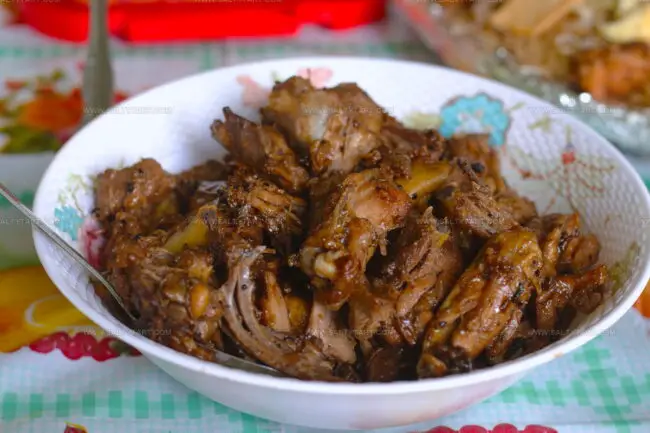




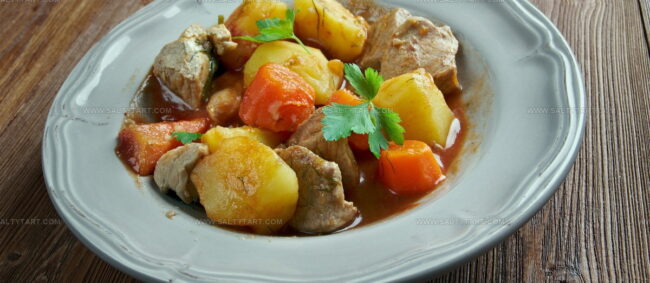
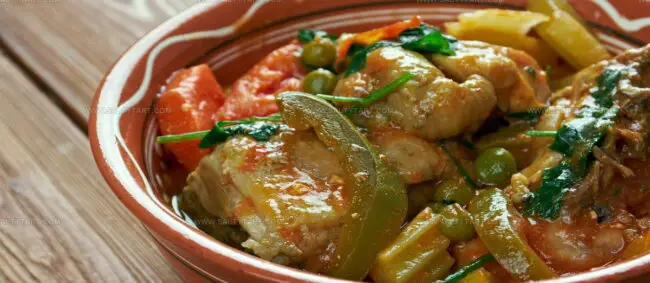
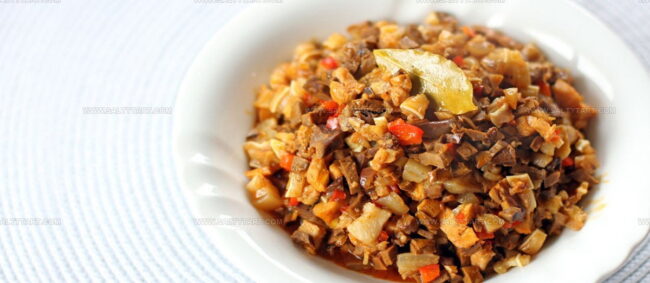
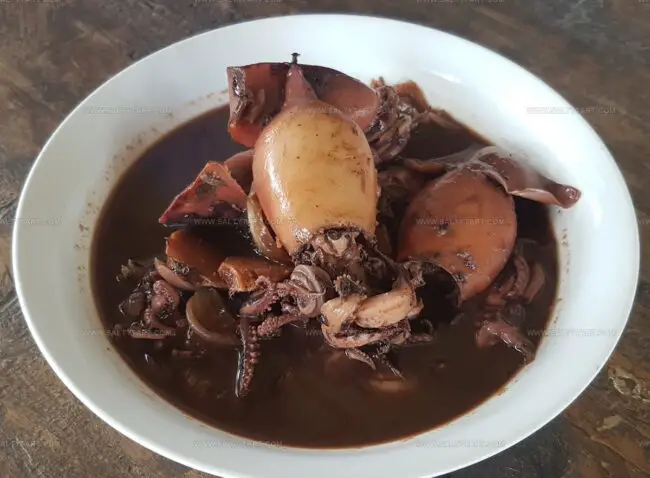

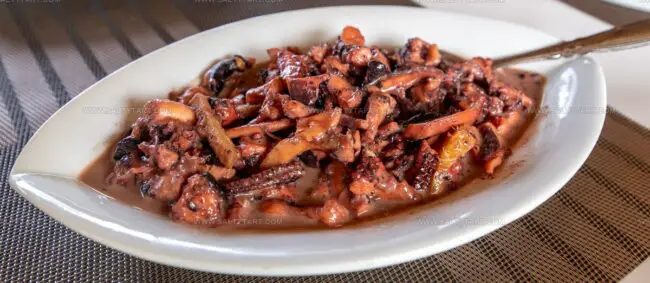
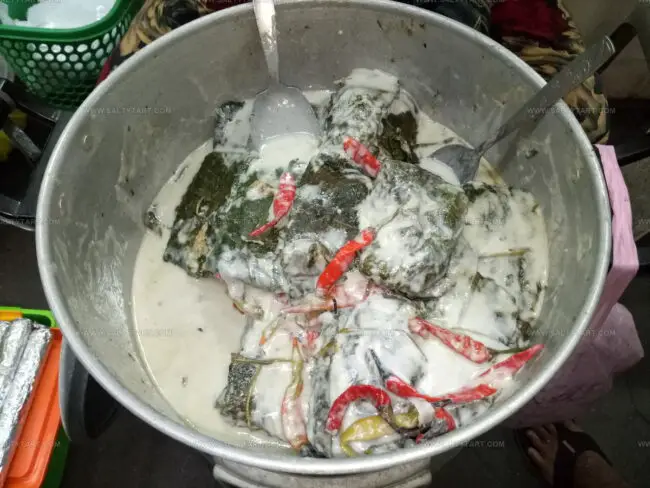
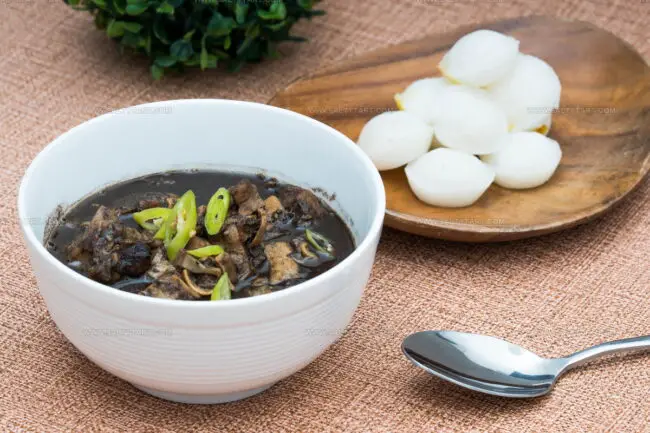
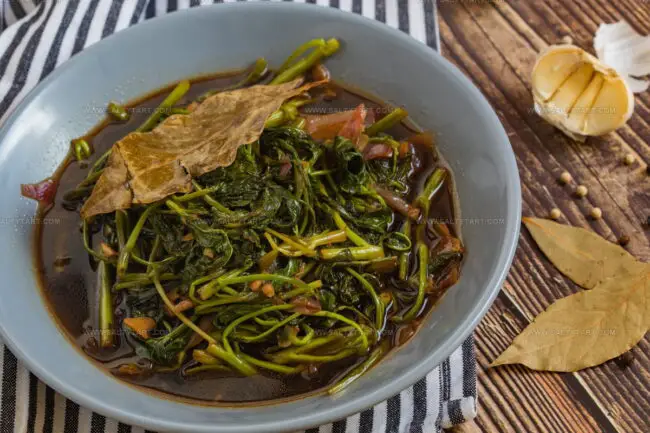

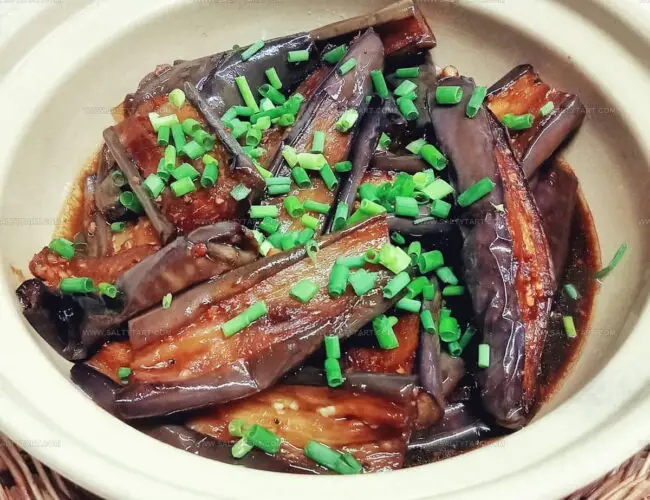
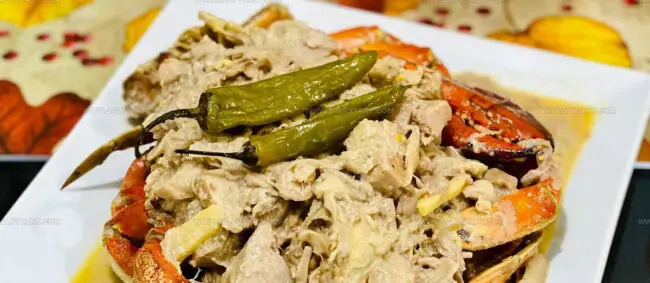

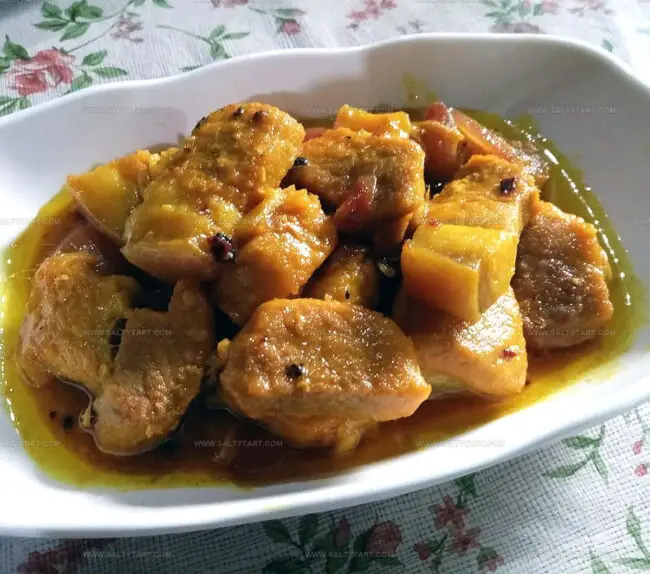
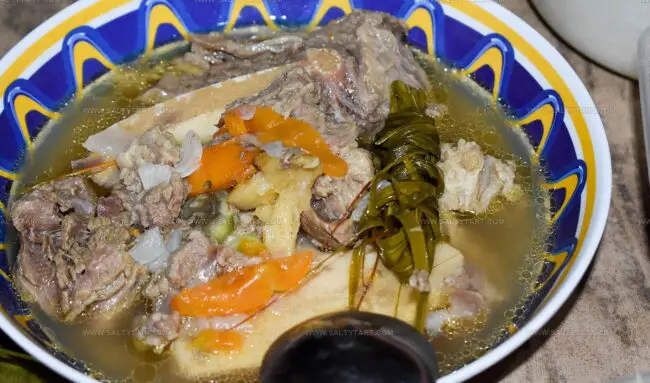
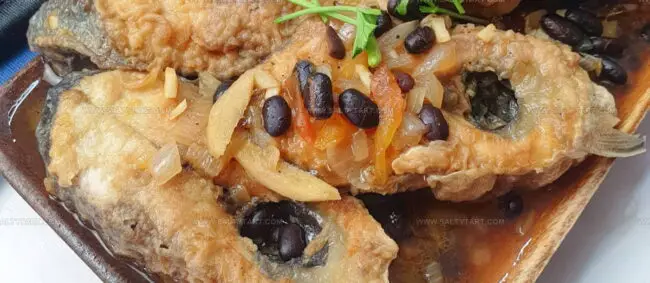
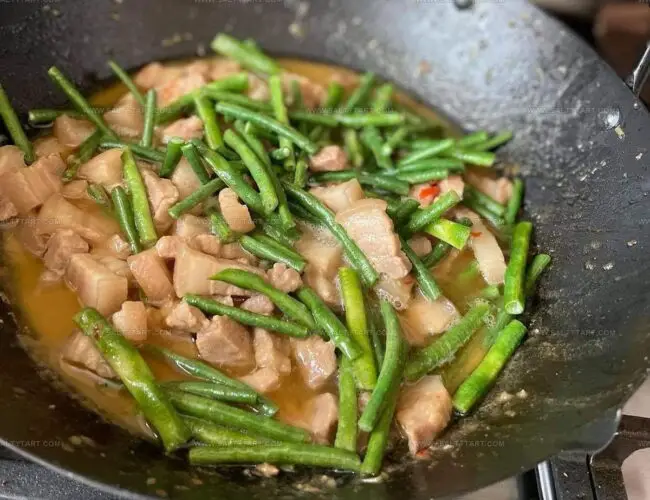
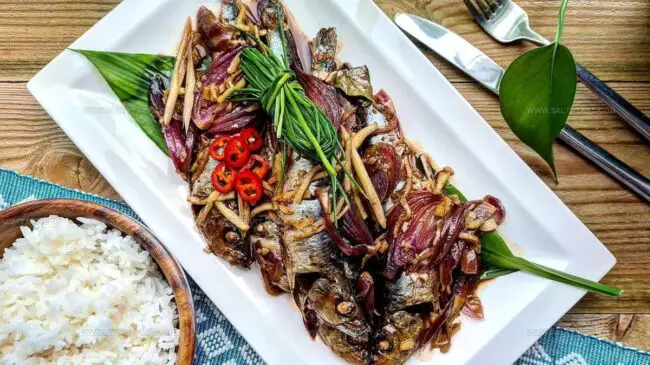
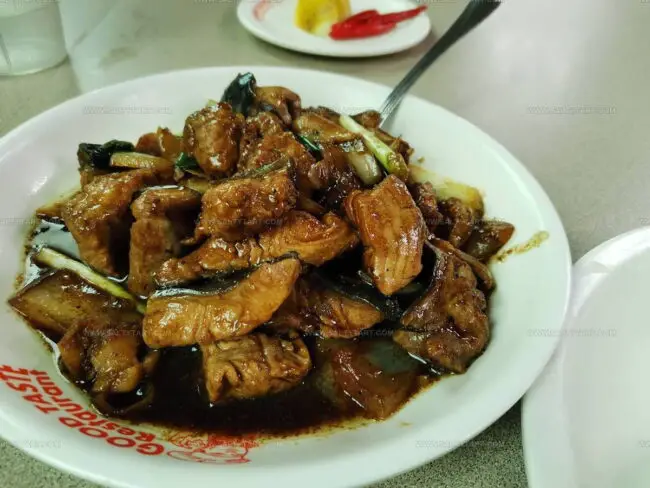
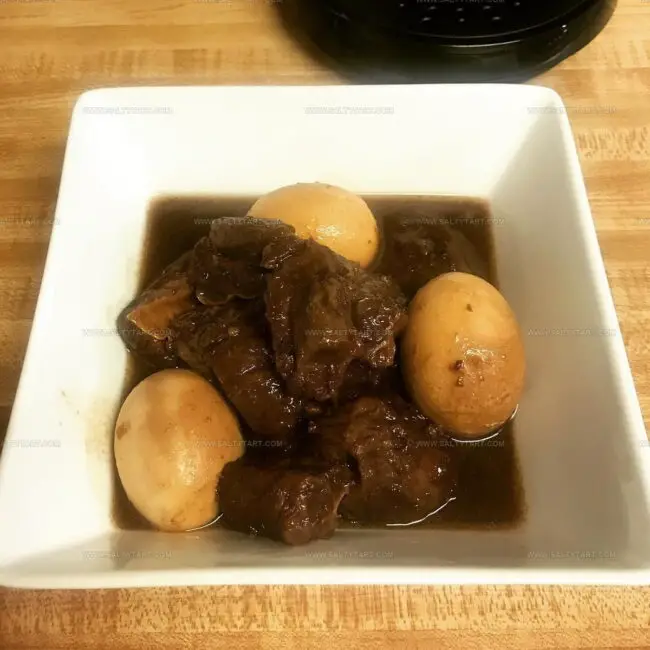
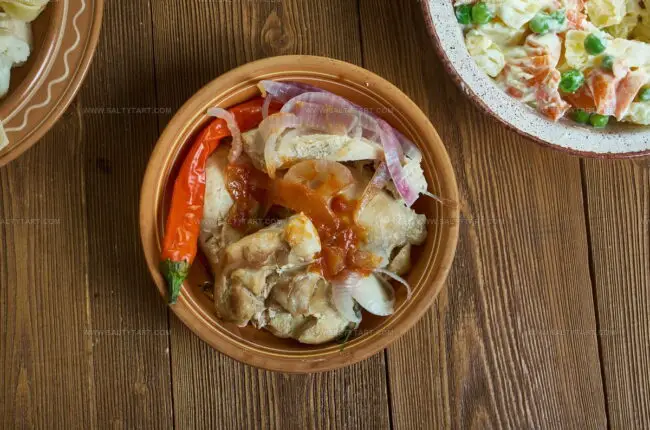

Jess Martinez
Contributing Recipe Writer & Nutrition Consultant
Expertise
Southwestern and Latin American cooking, Nutritional analysis and healthy recipe planning, Cultural food traditions, Modifying traditional dishes for better health
Education
Santa Fe Community College
Certificate in Culinary Arts
Focused on mastering the flavors and cooking methods of traditional Southwestern cuisine.
Jess’s love for bold, homegrown flavors led her straight into the world of Southwestern cooking and cultural nutrition.
After completing her Certificate in Culinary Arts at Santa Fe Community College, she made it her mission to show that good-for-you food can still taste incredible.
At saltytart.com, Jess shares vibrant, health-conscious recipes with roots in tradition but a fresh, modern twist. When she’s not testing new recipes, you’ll find her at local growers’ markets, tending her herb garden, or digging into food history books.